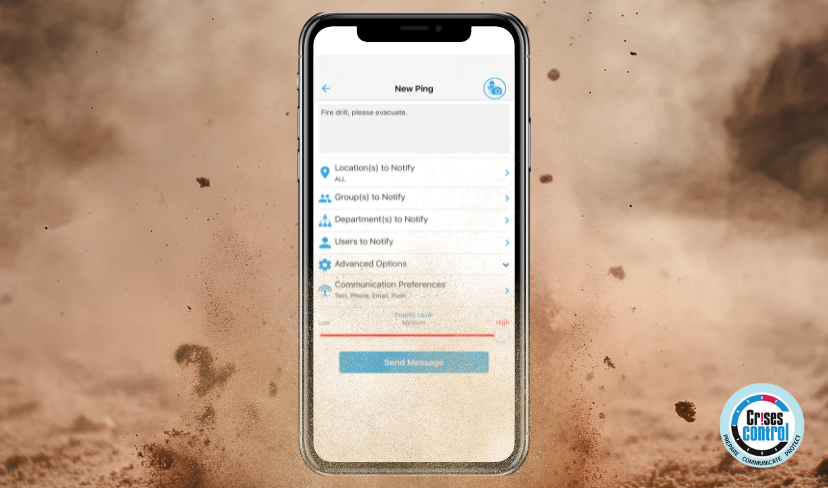Written by Anneri Fourie | Marketing Executive
Natural disasters are unpredictable, disruptive, and increasingly common events that can pose severe threats to businesses. Hurricanes, floods, earthquakes, and wildfires can bring operations to a standstill, endanger lives, and cause significant financial losses. In such situations, the ability to respond quickly and effectively is not just a competitive advantage; it’s a necessity. That’s where Emergency Alert Software comes into play.
This blog explores why every business needs emergency alert software for natural disasters, delving into its capabilities, benefits, and how Crises Control can be your strategic partner in crisis management.
The Growing Threat of Natural Disasters to Businesses
Natural disasters are on the rise, and businesses worldwide are feeling the impact. According to the World Meteorological Organization, the number of weather-related disasters has increased fivefold over the past 50 years. For businesses, this means more frequent interruptions, asset damage, and safety risks for employees.
However, many companies remain vulnerable because they rely on outdated communication methods like emails and phone trees, which are often too slow and unreliable when every second counts. Businesses need a robust and efficient way to communicate critical information during crises to ensure their employees’ safety and the continuity of operations. This is where Emergency Alert Software proves essential.
What is Emergency Alert Software?
Emergency Alert Software is a specialised communication tool designed to deliver real-time alerts and instructions during emergencies, such as natural disasters. Unlike traditional methods, it offers multi-channel communication, allowing businesses to send notifications via SMS, email, mobile apps, and voice calls instantly. But it’s not just about sending alerts; it’s a comprehensive crisis management solution that helps businesses plan, execute, and evaluate their disaster response strategies.
Key Features of Emergency Alert Software
- Multi-Channel Communication: Sends alerts through various platforms to ensure everyone receives the message, regardless of their device or location.
- Geolocation Targeting: Enables targeted alerts based on the recipient’s location, ensuring only those in the affected area receive critical information.
- Real-Time Reporting and Analytics: Provides insights into message delivery and response rates, helping businesses continuously improve their emergency response plans.
- Integration with Incident Management: Links alerting with incident management workflows, allowing businesses to manage all aspects of disaster response in one place.
How Emergency Alert Software Mitigates the Impact of Natural Disasters
Emergency Alert Software empowers businesses to act swiftly and confidently in the face of natural disasters. Here’s how it can make a crucial difference:
1. Enhancing Real-Time Communication During Crises
When a disaster strikes, clear and immediate communication is critical. Emergency Alert Software allows businesses to send alerts instantly, notifying employees about the situation and providing safety guidance. This real-time communication reduces confusion and ensures everyone knows what actions to take.
For example, during a sudden flood, employees can receive location-specific alerts about evacuation routes, road closures, and shelter locations. This targeted communication is far more effective than broad, generic alerts that might miss the mark.
2. Improving Decision-Making with Accurate Information
In a natural disaster, decisions need to be made quickly and based on reliable information. Emergency Alert Software can provide real-time data, including weather updates, incident reports, and employee check-ins. This information enables managers to assess the situation accurately and decide on the best course of action.
The software also facilitates two-way communication, allowing employees to report their status or raise concerns, which is crucial during rapidly evolving situations. For example, if an employee is trapped or needs assistance, they can alert management instantly, ensuring a quicker response.
3. Protecting Employees and Assets
Employee safety is the top priority during any crisis. Emergency Alert Software helps guide employees to safety by providing clear instructions, whether to evacuate, shelter in place, or follow specific protocols. Quick and precise alerts significantly reduce the risk of injuries or fatalities.
The software also helps protect physical assets by alerting staff about potential threats in time to take preventive measures. For instance, during a wildfire, employees can be instructed to secure critical equipment and shut down operations, minimising potential damage.
4. Ensuring Business Continuity
Natural disasters often lead to significant operational disruptions. Emergency Alert Software helps businesses mobilise their disaster recovery plans, coordinate with remote teams, and maintain critical functions even during a crisis. This continuity is essential for financial stability and maintaining trust with customers, stakeholders, and employees.
How Crises Control’s Emergency Alert Software Stands Out

Crises Control offers a leading emergency alert platform tailored to support businesses during natural disasters. Here’s how Crises Control can enhance your crisis management efforts:
1. Mass Notification System for Instant Alerts
Crises Control’s Ping Mass Notification system ensures alerts are sent instantly across multiple channels, including SMS, email, voice calls, and in-app notifications. This multi-channel approach guarantees that your message reaches everyone, regardless of location or device, ensuring no one is left uninformed during a critical event.
2. Advanced Geolocation Capabilities
With Crises Control, you can send alerts based on location, ensuring that only those directly impacted receive the information they need. This feature is invaluable during localised disasters like floods or wildfires, where conditions can vary even within a small radius, allowing you to provide relevant, timely information to those who need it most.
3. Incident Manager for Coordinated Response
Crises Control’s Incident Manager integrates seamlessly with the alerting system to provide a comprehensive incident management solution. This tool helps businesses track incidents in real-time, assign tasks, and monitor progress, ensuring a coordinated and efficient response to any disaster. Whether you’re dealing with an ongoing crisis or preparing for the next one, Incident Manager keeps all actions organised and aligned with your response plans.
4.Task Manager for Streamlined Operations
Task Manager allows you to assign specific tasks to team members during an emergency, ensuring that everyone knows their role and responsibilities. This feature supports the smooth execution of your emergency plans by providing real-time updates on task completion, prioritising critical actions, and eliminating the chaos that often accompanies crisis situations. By managing tasks efficiently, businesses can minimise downtime and focus on protecting employees and assets.
5. Incident Plan Builder for Proactive Preparedness
The Incident Plan Builder empowers businesses to create detailed, customised incident response plans tailored to various scenarios, including natural disasters. By having these plans built and ready to deploy, you can respond swiftly and effectively when a crisis strikes. The Incident Plan Builder allows for continuous improvement, letting you update and refine your plans based on past incidents and evolving risks.
6. SOS Panic Button for Immediate Assistance
In high-stress situations, employees need a quick way to call for help. Crises Control’s SOS Panic Button feature allows employees to discreetly alert security or emergency services when in distress, ensuring help is just a click away. This immediate line of communication can be lifesaving during natural disasters when every second counts.
7. Independent Cloud Infrastructure
Unlike other providers, Crises Control operates independently of major cloud services like Microsoft, ensuring continued operation even when traditional networks are down. This resilience is critical during large-scale disasters that can disrupt standard communication channels, providing businesses with reliable and uninterrupted access to their emergency alert system.
8. Comprehensive Reporting for Continuous Improvement
After a disaster, understanding what went right and what didn’t is crucial. Crises Control provides detailed reports and audit trails of all communications and actions, helping businesses refine their emergency plans and meet compliance standards. These insights are invaluable for continuous improvement, ensuring your response becomes more effective with every incident.
Conclusion: Be Prepared with Crises Control
Natural disasters are unpredictable, but your response doesn’t have to be. Emergency Alert Software is no longer a luxury—it’s essential for any business that prioritises the safety of its people and the continuity of its operations. Crises Control’s comprehensive platform provides everything you need to stay connected, informed, and in control when it matters most.
Ready to strengthen your disaster preparedness? Contact us today for a free personalised demo of Crises Control’s Emergency Alert Software and discover how it can transform your crisis management strategy.
Request a FREE Demo

